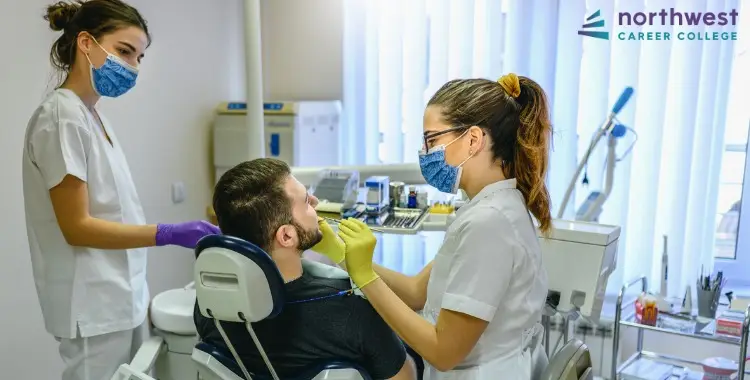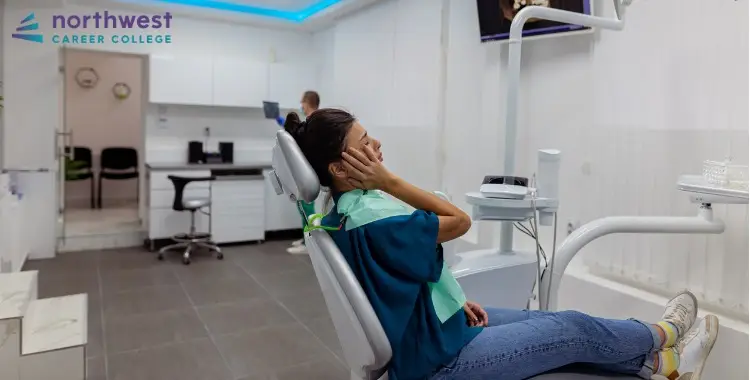A Guide to Infection Control for Dental Assistants – Part 2
- Dental Assistant
- March 11, 2025
- 2.1k views
- 5 min read

If you are a current or aspiring dental assistant, this article is for you! If you haven’t read our last article, check out A Guide to Infection Control for Dental Assistants – Part 1 for a detailed description of the infection control best practices that we recommend you incorporate into your practice.
In that article we talked about why infection control is so important…given that it is essential to keeping ourselves, our team members, and our patients safe, it can seem self-evident but it’s important to reiterate!
We also discussed why is important for dental assistants to be confident about infection control best practices…not only do dentists expect this as part of their employment, it is because dental assistants are on the front lines of patient care. You perform such tasks as preparing the treatment area to assist dentists with procedures that expose you to infectious agents, so it truly is essential knowledge for dental assistants.
We performed an in-depth exploration of the importance of hand hygiene. We addressed that proper hand hygiene is the cornerstone of effective infection control because our hands can so easily transmit diseases. We also acknowledged how failure to maintain good hand hygiene will undermine the effectiveness of every other infection control practice.
We also reviewed the proper use of Personal Protective Equipment (PPE). PPE, like hand hygiene, is vital to reduce the risk of infection. Proper PPE includes gloves, masks, eye protection, and sometimes face shields when performing procedures that might produce splashes or sprays of blood or saliva. PPE may also include disposable gowns or lab coats, although this is not standard across all offices.
Finally, we discussed the importance of surface disinfection. We placed significant emphasis on the disinfection of high-risk surfaces such as the patient’s dental chair, the operator’s dental chair, assistant dental stools, other components of the dental operatory, and computer equipment. However, it should not be overlooked that other low-risk surfaces (e.g. the walls, handles in non-clinical areas, etc.) must still be periodically disinfected.
This article will walk you through the next infection control best practice that we recommend that you incorporate into your dental office playbook!
Table of Contents
Sterile Equipment and Clean Instruments
One of the primary responsibilities of dental assistants in the dental practice is maintenance of the sterilization area. It may seem like an easy task on its surface (who among us has never cleaned dishes and utensils before?), but the requirements to ensure proper sterilization or high-level disinfection of dental instruments are quite precise.
Using sterile instruments and ensuring that all non-disposable tools are properly cleaned and sterilized before use is non-negotiable in dental practices. Single-use items should be disposed of immediately after use, and reusable tools must undergo strict sterilization protocols. This approach helps prevent the transmission of infections via equipment surfaces.
Proper infection control procedures related to cleaning reusable instruments start when the room is broken down. While this is not technically part of cleaning the instruments themselves, dental assistants must be cognizant of contaminated instruments when breaking down a room to ensure they do not accidentally stick themselves with a sharp instrument. Such an injury would derail the cleaning process and necessitate medical attention if the injury breaks the skin.
Dental assistants must then transfer dirty instruments to the sterilization area to begin the formal cleaning process. Dental assistants must pre-clean the instruments using a scrub brush and/or ultrasonic cleaner to remove gross debris (similar to pre-washing your dishes before they go in the dishwasher!). They must take care to use utility gloves when handling these contaminated instruments, as they are at higher risk for exposure during this pre-cleaning process.
Once instruments have been pre-cleaned, most must be packaged in sterilization pouches and prepared for the autoclave. Dental assistants are also responsible for ensuring the pouches are packed properly, both within the pouches themselves and within the autoclave.
Instruments must be properly arranged within within the pouches themselves, as there should only be one layer of instruments within the bag to ensure adequate heat is applied to all instruments. It is a common mistake for assistants to over-pack sterilization pouches, which results in less effective sterilization for instruments in the middle of the pouch.
Instrument pouches must also be properly arranged within the autoclave. Similar to how instruments are supposed to be arranged in a single layer within a pouch itself, care must be taken to ensure pouches are not stacked multiple layers deep within an autoclave tray or cassette, for similar reasons. If the heat cannot evenly and equally penetrate the various instrument pouches, they will not all receive equal benefit.
Finally, once instruments are sterilized, they must be carefully stored within designated drawers, cabinets, etc., either in the front office or within operatories. Sterilization pouches can keep instruments free of contamination for weeks or months (even years according to some clinical observations) as long as they remain intact. If the pouches are exposed to contaminants or are breached by instrument tips, then they will become contaminated and need to be sterilized.
Conclusion
Part three of this article will review several other significant areas related to infection control in the dental office. It should be published soon, so don’t forget to return to learn more!





